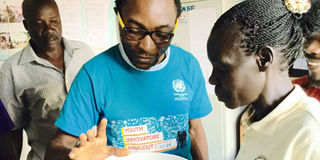RootIO: the COMMUNITY RADIO in A BUCKET

Jude Mukundane demonstrates how the radio station in a bucket works to community leaders in Patongo Sub-county. COURTESY PHOTO
This Friday is World Radio Day. This day is about celebrating radio, why we love it and why we need it today more than ever. A day to remember the unique power of radio to touch lives and bring people together across the globe.
Radio is a low-cost medium, specifically suited to reach remote communities and vulnerable people: the illiterate, the disabled, women, youth and the poor, while offering a platform to intervene in public debate, irrespective of people’s educational levels.
In rural Uganda, radio is the most common way to access and disseminate information. That said, in case the people need to put out information and discuss issues concerning the community and their livelihood, they will need money to get airtime on the radio station.
With an android phone, a transmitter and a bucket, a project called RootIO is out to minimise these issues by empowering communities with a solution that will make it possible for communities to control and run their own information within the community.
What it is
RootIO is an acronym for Grassroots Radio for Community Input and Output. It is the brainchild of Christopher Csikszentmihalyi and Jude Mukundane. Csikszentmihalyi heads European Research Area Chair and Scientific at the Madeira Interactive Technology Institute, while Jude was formerly head of VAS engineering and Technology Innovations at Uganda Telecom.
The pair says the RootIO project was born out of the realisation that people at the grassroots, especially in rural regions of developing nations ,primarily depend on radio to access information.
“In some of these rural areas they have to get a person with a bicycle and a megaphone to make rounds around the community making announcements or pin up the announcement at local office noticeboards and hope that the people will get to see them,” Mukundane says.
With radio, it is easy for the people to get information regardless of the place and literacy level.
“Radio is preferred for obvious reasons - it is free to access, it spans large geographical areas with relatively minimal infrastructure and it does not require literacy for anyone to access it,” says Csikszentmihalyi.
Mukundane adds:“RootIO enables people who primarily rely on radio for their information needs to own radio stations by scaling down the economic dynamics (like buying heavy machinery and human resource) of radio to the point where communities can run them without suffering the financial and skill burdens that befall typical radio stations.”
Pilot project
Uganda Communications Commission recently flagged off the project to run a pilot authorisation for six months. The broadcasting coverage will be able to cover a distance of up to 35km on flat terrain areas. Communities set to benefit from this pilot project include Patongo in Agago, Kitgum Town, Pabbo Sub-county in Amuru District, and Aber Sub-county in Oyam District.
This will commence after establishing partnership with community based organisations and local government leadership with the hope of scaling to many more communities soon.
The UCC will allocate a frequency for the community members to tune into the station
Jane Margaret Adong, the Gwokke programme coordinator in Agago District says this project will reduce the burden of travelling to radio stations which are far and expensive for the people.
She adds, “With this project we will be able to combat land degradation by urging people to plant trees and also help in the prevention of diseases like HIV because mass sensitisation will be easy.”
RootIO was made possible by a grant from John S. and James L. Knight Foundation and is supported for extended deployment in rural communities in Uganda by the Resilient Africa Network.
How it works
It is intended to cater for a small community that decides what they want to air on the radio.
Instead of a big studio and large equipment, you need an android phone and an FM transmitter to run this radio. It is not for commercial purposes but rather it simplifies communication for the people in the community.
The people in the community man the radio. They can choose anyone to do it and if anyone has any communication, they call the phone and directly go on air.
The radio is strategically placed at community centres that are easily accessible for the people.




